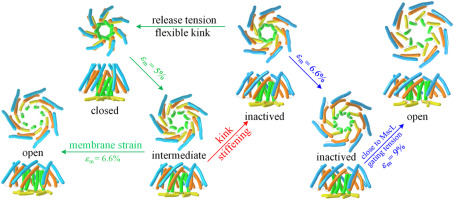Journal of the Mechanical Behavior of Biomedical Materials ( IF 3.9 ) Pub Date : 2018-11-02 , DOI: 10.1016/j.jmbbm.2018.10.040 Liangliang Zhu 1 , Qiang Cui 2 , Hang Xiao 3 , Xiangbiao Liao 3 , Xi Chen 4

|
Mechanosensitive channels of small conductance (MscS) in Escherichia coli (E. coli) serve as a paradigm for understanding the gating behaviors of the MscS family of ion channels. In this work, we develop a continuum mechanics framework to explore the conformational states of MscS during the gating transition. A complete gating transition trajectory from the closed to the open state along with partially open intermediates is obtained, and the open structure is close to the available structural model from crystallographic studies. The computational efficiency of the modeling framework makes it possible to explore the roles of various structural elements (e.g., loops that connect transmembrane helices) and specific interactions in the gating transition. It is observed that removing either the Asp62-Arg131 salt bridge or the Phe68-Leu111 non-polar interaction leads to essentially non-conducting structures even with a membrane tension close to the lysis limit. The loop connecting TM2 (the second transmembrane helix) and TM3 is found to be essential for force transmission during gating, while the loop connecting TM1 and TM2 does not make any major contribution. Based on the different structural evolutions observed when the TM3 kink is treated as a loop or a helical segment, we propose that the helical propensity of the kink plays a central role in inactivation; i.e., under prolonged sub-threshold membrane tension, transition of the initially flexible loop to a helical segment in TM3 may lead to MscS inactivation. Finally, the gating transition of MscS under different transmembrane voltages is explored and found to be essentially voltage independent. Collectively, results from the current continuum mechanics analysis provide further insights into the gating transition of MscS at structural and physical levels, and specific predictions are proposed for further experimental investigations.
中文翻译:

小电导的机械敏感通道的门控和失活:连续力学研究。
大肠杆菌(E. coli)中的小电导(MscS)的机械敏感通道)是理解MscS系列离子通道门控行为的范例。在这项工作中,我们开发了一个连续的力学框架来探索门控过渡过程中MscS的构象状态。获得了从封闭状态到开放状态的完整门控过渡轨迹以及部分开放的中间体,并且开放结构接近晶体学研究中可用的结构模型。建模框架的计算效率使得有可能探索各种结构元素(例如,连接跨膜螺旋的环)的作用以及门控过渡中的特定相互作用。观察到,即使膜张力接近裂解极限,去除Asp62-Arg131盐桥或Phe68-Leu111非极性相互作用也会导致基本不导电的结构。发现连接TM2(第二个跨膜螺旋)和TM3的回路对于门控过程中的力传递至关重要,而连接TM1和TM2的回路没有任何重要作用。基于将TM3纽结视为环或螺旋段时观察到的不同结构演变,我们认为纽结的螺旋倾向在失活中起着核心作用;也就是说,在延长的亚阈值膜张力下,最初的柔性环过渡到TM3中的螺旋段可能会导致MscS失活。最后,探索了在不同跨膜电压下MscS的门控跃迁,发现它基本上与电压无关。总的来说,当前连续力学分析的结果为MscS在结构和物理水平上的门控转变提供了进一步的见识,并提出了具体的预测以用于进一步的实验研究。



























 京公网安备 11010802027423号
京公网安备 11010802027423号